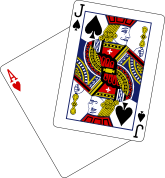Abstract
Blackjack is the only game offered by casinos, where it is proven that players can beat the dealer on the long term. Many books and articles have been published about this theme, however most of them are written to make you lose money. The only way of having a moderate advantage over the dealer is to count cards remaining in the shoe, placing variable bets and deciding when to stay or buy, double or split. An analysis on how this works is described in this document.
It is assumed that the reader of this document is familiar with some basic understanding in probability calculation and terminology. The program code used to calculate these results can be downloaded from this site, so that everybody can verify and compare them to their preferred counting method.
Why do casinos still offer Blackjack if players can beat the dealer?
Because most people don't know how it works. So they still continue to lose their money. Casinos know that, and those few who really are capable to exploit the rules are of no consequence. In order to have a moderate advantage over the Blackjack dealer, a player must keep track of the cards which have gone. Or put it the other way: A player must know which cards are still in the shoe. This means that he has to count cards. If you find articles about winning Blackjack methods without card counting, please ignore them. It often seems as if authors of such articles and books do not even understand the sources they are copying.
In order to win, gamblers must not only know when to buy or stay, double or split, they also must know when to place minimum stakes and when to bet high. Without this knowledge there is no way to win on the long term.
Remember - there is absolutely no way to win on the long term playing Blackjack without counting cards!
Probability and expectation
Let me explain what is meant by "On the long term". As an easier understandable example lets choose Roulette. There are 38 pockets (37 in European casinos), of which 18 are red, 18 are black and two (one in Europe) are green. The probability that the ball rolls at the seeded number is 1/38=2.6% (1/37=2.7% in Europe). The probability that the ball rolls at the seeded color is 18/38=47.3% (18/37=48.6% in Europe).
On the long term means that after N games a seeded number should be hitten k times, where k=N/38±x (k=N/37±x in Europe). If this experiment is repeated very often, the relative deviation x/N from the theoretical probability will decrease with the number of games, whereas the absolute deviation x can increase.
An other very important term is expectation: This is the percentual gain or loss. The expectation can be calculated for a single decision or for an entire strategy. It is the (probability for winning * gain) - (probability of loss * stake). In this article, expectations are far more interesting than probabilities.
Experienced gamblers
The terms probability and expectation are quite theoretical because an average gambler will never play that many games in order to get significant statistics over his decisions. This means that there are no experienced gamblers, or to say it in other words: through gambling you can not aquire the knowledge how to find the right decision. All self assessed experienced gamblers lost and will lose their money. In order to get statistical significant results, millions and millions of games would have to be played. This is only possible through computer simulation. A gambler playing Roulette can't do many wrong decisions but he also can't do many right ones either (except quitting to gamble of course). On the other side a gambler playing Blackjack has many more possibilities, giving him plenty of opportunity to do the wrong decisions. And the majority of Blackjack gamblers make the wrong decisions over and over again.
Many articles have been written about playing Blackjack in order to beat the dealer. Most notably is the book from Edward O. Thorp: Beat the Dealer, innumerable others followed. The serious ones present one or more counting methods to find out the best strategy when betting high, stay or buy, double or split. This article presents no existing or new counting method but a program to calculate the best strategy upon the momentary distribution of cards in the shoe. This program is very small (less than 60kB of source) and has no graphical user interface. It is thus easily adoptable in embedded systems. As casinos do not allow any kind of computers, a graphical user interface would be of no usage anyway.


